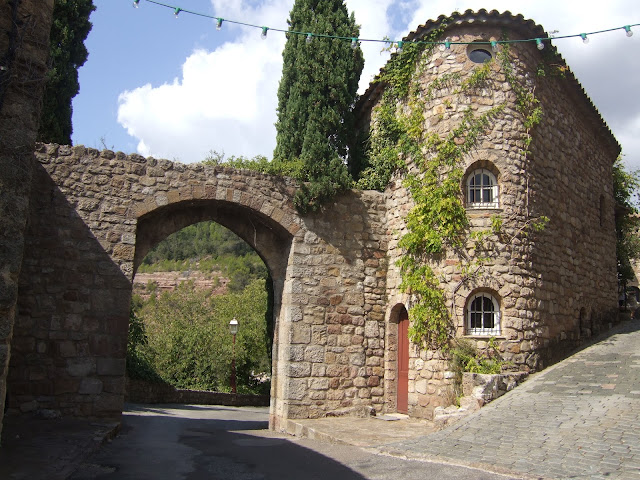 |
| The crowd gathers outside the lower gate to listen to the story of Le Parage. |
Every second year in July, Les Arcs-sur-Argens holds a
renowned medieval festival that takes place over several days. It is an incredible spectacle - and a 'must see' for visitors to the town arriving in the odd-numbered years.
But all is not forgotten in the intervening ‘even’ year,
when the same actors present a smaller version of the town’s history in the ‘vieille ville’ – the medieval part of
Les Arcs known as Le Parage.
Led by the enthusiastic ex-journalist, Georges Yvedian, who
as MC, outlines the history of the old town, its people, and introduces the
small scenes that are staged at various points along the way.
 |
| Georges Yvedian explains the Miracle of the Roses to the crowd during one of the scenes. |
Known as ‘Les Flambeaux
d’Arcus’, the spectacle meanders up along the narrow stepped streets of the
Parage and ends right at the top of
the village with a display of dancing and medieval food and drinks served to the audience.
 |
| The crowd follows the actors up through the narrow streets. |
We gather in Place Paul Simon, at the bottom of our street,
where a scene is enacted at the former Hôpital
St Jacques (now the Creperie). It is almost 9.30pm but still just light.
Then we follow the flaming beacons up the street (past our
house) to the basse porte – or lower
gate to the old village – where another scene takes place. Monsieur Yvédian
also explains the restoration of the Parage
in the 1960s, after it had fallen into grave disrepair.
It was mandated that the entire village remain
pedestrianised; that there would be no commerce within its walls; and that
those buying houses would be required to rebuild in the medieval style.
We move on to La Fontaine du Temps, where the main storyline emerges of a young girl falling in
love.
This fountain, with its wall of water (a tiny version of the one at Melbourne’s National Gallery of Art) is situated in a small square which features a wall tiled with the story of Le Jardin d'Eden - the Garden of Eden - by artist Mary Dallos in 1968 and a painted sundial showing the meeting of the Knight of St John of Jerusalem, Helion de Villeneuve (1270-1346), who lived in the chateau above, and his sister, Roseline (1263-1329) - later Sainte Roseline, before she entered the convent.
This fountain, with its wall of water (a tiny version of the one at Melbourne’s National Gallery of Art) is situated in a small square which features a wall tiled with the story of Le Jardin d'Eden - the Garden of Eden - by artist Mary Dallos in 1968 and a painted sundial showing the meeting of the Knight of St John of Jerusalem, Helion de Villeneuve (1270-1346), who lived in the chateau above, and his sister, Roseline (1263-1329) - later Sainte Roseline, before she entered the convent.
 |
| Young Roseline's first 'miracle of the roses'. |
On we climb, a long, moving snake of people, jostling
together, chatting, children carried high on shoulders or edging forward
between the grown-ups to better appreciate the show. It takes time to assemble
and find good vantage points and Monsieur Yvédian waits patiently for us.
There is another scene at the Place du Collier, then at Place du
Microcoulier, where we pause in front of the medieval Chapelle St Pierre. A lone tambourinaire beats a mournful pattern
on his drum as penitents from the religious order carry a coffin out of the
chapel to the cemetery.
We are told that the chapel once also housed a hospital –
and the cemetery was next to it. Read into that what you may! But if you go
inside the chapel when it is open, you can look down through a glass partition set
into the floor and see several ancient skeletons lying below.
Next we move right up to the old donjon – the tower which soars squarely above the town. Just below
it is the ‘La Porte du Miracle des Roses’ where
the young Roseline Villeneuve produced her first miracle.
She would steal her father’s bread stores to feed the poor,
and one day he caught her, demanding that she open her apron and reveal the
bread. Miraculously, when she unfurled her apron, hundreds of roses tumbled
out.
 |
| The betrothed couple after receiving her father's permission to marry. |
By now, the original young girl’s father – a knight – has just returned from the crusades with news of the battles. But for him it is the news of the young man seeking his daughter’s hand in marriage that is most important.
Naturally his permission is granted and all ends happily.
There is medieval dancing and much merriment in the square – and when it finishes we all receive a delicious glass of a honeyed liqueur laced with some interesting herbs (I would really like the recipe for that one!) and a semi-circle of sweet bread to go with it.
We sit and listen to more of the music – medieval of course
– before wending our way back down through the village by the light of an
almost-full moon.
 |
| Medieval dancing in the Place Pere Clinchard. |
Les Flambeaux d’Arcus
is performed every Friday night throughout July and August in Les Arcs.

























